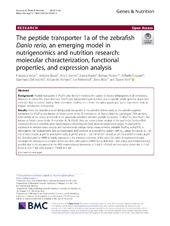| dc.contributor.author | Vacca, Francesca | |
| dc.contributor.author | Barca, Amilcare | |
| dc.contributor.author | Gomes, Ana S. | |
| dc.contributor.author | Mazzei, Aurora | |
| dc.contributor.author | Piccinni, Barbara | |
| dc.contributor.author | Cinquetti, Raffaella | |
| dc.contributor.author | Del Vecchio, Gianmarco | |
| dc.contributor.author | Romano, Alessandro | |
| dc.contributor.author | Rønnestad, Ivar | |
| dc.contributor.author | Bossi, Elena | |
| dc.contributor.author | Verri, Tiziano | |
| dc.date.accessioned | 2020-05-08T13:00:48Z | |
| dc.date.available | 2020-05-08T13:00:48Z | |
| dc.date.issued | 2019-12-19 | |
| dc.Published | Vacca F, Barca A, Gomes AS, Mazzei A, et al. The peptide transporter 1a of the zebrafish Danio rerio, an emerging model in nutrigenomics and nutrition research: Molecular characterization, functional properties, and expression analysis. Genes & Nutrition. 2019;14:33 | eng |
| dc.identifier.issn | 1555-8932 | en_US |
| dc.identifier.issn | 1865-3499 | en_US |
| dc.identifier.uri | http://hdl.handle.net/1956/22150 | |
| dc.description.abstract | Background: Peptide transporter 1 (PepT1, alias Slc15a1) mediates the uptake of dietary di/tripeptides in all vertebrates. However, in teleost fish, more than one PepT1-type transporter might function, due to specific whole genome duplication event(s) that occurred during their evolution leading to a more complex paralogue gene repertoire than in higher vertebrates (tetrapods). Results: Here, we describe a novel di/tripeptide transporter in the zebrafish (Danio rerio), i.e., the zebrafish peptide transporter 1a (PepT1a; also known as Solute carrier family 15 member a1, Slc15a1a), which is a paralogue (78% similarity, 62% identity at the amino acid level) of the previously described zebrafish peptide transporter 1b (PepT1b, alias PepT1; also known as Solute carrier family 15 member 1b, Slc15a1b). Also, we report a basic analysis of the pept1a (slc15a1a) mRNA expression levels in zebrafish adult tissues/organs and embryonic/early larval developmental stages. As assessed by expression in Xenopus laevis oocytes and two-electrode voltage clamp measurements, zebrafish PepT1a, as PepT1b, is electrogenic, Na+-independent, and pH-dependent and functions as a low-affinity system, with K0.5 values for Gly-Gln at − 60 mV of 6.92 mmol/L at pH 7.6 and 0.24 mmol/L at pH 6.5 and at − 120 mV of 3.61 mmol/L at pH 7.6 and 0.45 mmol/L at pH 6.5. Zebrafish pept1a mRNA is highly expressed in the intestine and ovary of the adult fish, while its expression in early development undergoes a complex trend over time, with pept1a mRNA being detected 1 and 2 days post-fertilization (dpf), possibly due to its occurrence in the RNA maternal pool, decreasing at 3 dpf (~ 0.5-fold) and increasing above the 1–2 dpf levels at 4 to 7 dpf, with a peak (~ 7-fold) at 6 dpf. Conclusions: We show that the zebrafish PepT1a-type transporter is functional and co-expressed with pept1b (slc15a1b) in the adult fish intestine. Its expression is also confirmed during the early phases of development when the yolk syncytial layer is present and yolk protein resorption processes are active. While completing the missing information on PepT1-type transporters function in the zebrafish, these results open to future investigations on the similar/differential role(s) of PepT1a/PepT1b in zebrafish and teleost fish physiology. | en_US |
| dc.language.iso | eng | eng |
| dc.publisher | BioMed Central (BMC) | en_US |
| dc.rights | Attribution CC BY | eng |
| dc.rights.uri | http://creativecommons.org/licenses/by/4.0/ | eng |
| dc.subject | Di/tripeptide transport(ers) | eng |
| dc.subject | Dietary protein | eng |
| dc.subject | Electrogenic transport | eng |
| dc.subject | Heterologous expression | eng |
| dc.subject | Peptide absorption | eng |
| dc.subject | pH-dependence | eng |
| dc.subject | Teleost fish | eng |
| dc.subject | Whole genome duplication | eng |
| dc.subject | Xenopus laevis oocytes | eng |
| dc.title | The peptide transporter 1a of the zebrafish Danio rerio, an emerging model in nutrigenomics and nutrition research: Molecular characterization, functional properties, and expression analysis | en_US |
| dc.type | Peer reviewed | |
| dc.type | Journal article | |
| dc.date.updated | 2020-02-04T10:20:37Z | |
| dc.description.version | publishedVersion | en_US |
| dc.rights.holder | Copyright 2019 The Author(s) | en_US |
| dc.identifier.doi | https://doi.org/10.1186/s12263-019-0657-3 | |
| dc.identifier.cristin | 1785368 | |
| dc.source.journal | Genes & Nutrition | |

